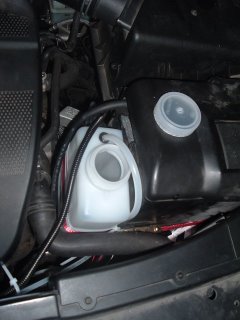Wow - major problems *already*
Wouldn't you know it, but as soon as I relocate the washer reservior I start getting problems. Some troublesome, some outright problematic. The short list:
- An air gap would appear in the line, preventing the pump from working properly.
- There appeared to be a parasitic drain issue, killing the battery overnight.
- The fluid hose would leak at several places.
- Electrical tape pulling loose at several solder joints.
- Relocate the resevior intake line to the side-bottom of the bottle. The hose no longer loops over the top, rather it all stays low.
- Use only minimal solder - too much creates resistance issues in circuits.
- Stay away from the electrical tape - shrink tube is much cleaner and a hell of a lot more effective.
- Two words - compression adapters. Thinking that simply sliding a 3/8" tube inside a 1/2" adapter tube was stupid.







